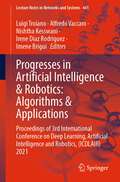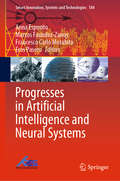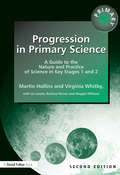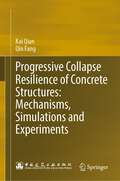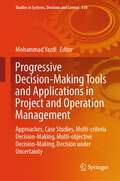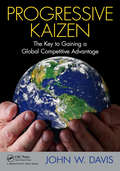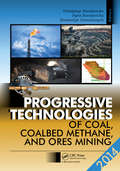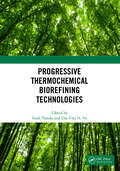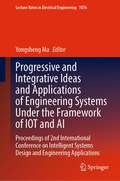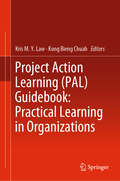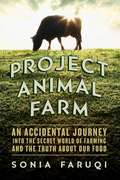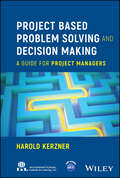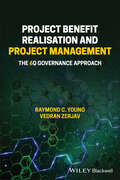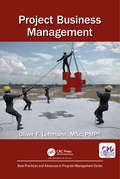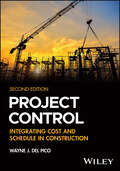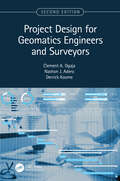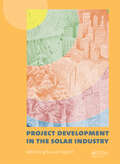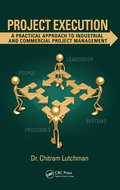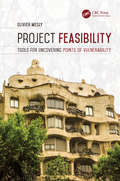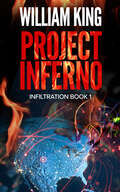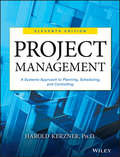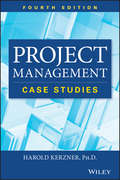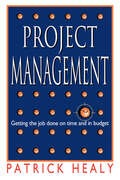- Table View
- List View
Progresses in Artificial Intelligence & Robotics: Proceedings of 3rd International Conference on Deep Learning, Artificial Intelligence and Robotics, (ICDLAIR) 2021 (Lecture Notes in Networks and Systems #441)
by Alfredo Vaccaro Luigi Troiano Nishtha Kesswani Irene Díaz Rodriguez Imene BriguiThis book presents new technologies and applications in deep learning, artificial intelligence and robotics. The field of machine intelligence (MI), unifying robotics and artificial intelligence is experiencing constant growth and change. The challenge to reproduce human behavior in machines requires the interaction of many fields, from engineering to mathematics, from neurology to biology, from computer science to robotics, from web search to social networks, from machine learning to game theory, etc. This book Progresses in Artificial Intelligence & Robotics : Algorithms & Applications (proceedings of 3rd International Conference on Deep Learning, Artificial Intelligence and Robotics (ICDLAIR) 2021 ) introduces key topics from artificial intelligence algorithms and programming organization and explains how they contribute to autonomous capabilities. The book is primarily intended for researchers, students, and engineers who wish to use the applications of artificial intelligence to solve concrete problems. We hope that companies and technology developers also find it interesting to be used in industry.
Progresses in Artificial Intelligence and Neural Systems (Smart Innovation, Systems and Technologies #184)
by Anna Esposito Marcos Faundez-Zanuy Francesco Carlo Morabito Eros PaseroThis book provides an overview of the current advances in artificial intelligence and neural nets. Artificial intelligence (AI) methods have shown great capabilities in modelling, prediction and recognition tasks supporting human–machine interaction.At the same time, the issue of emotion has gained increasing attention due to its relevance in achieving human-like interaction with machines. The real challenge is taking advantage of the emotional characterization of humans’ interactions to make computers interfacing with them emotionally and socially credible.The book assesses how and to what extent current sophisticated computational intelligence tools might support the multidisciplinary research on the characterization of appropriate system reactions to human emotions and expressions in interactive scenarios. Discussing the latest recent research trends, innovative approaches and future challenges in AI from interdisciplinary perspectives, it is a valuable resource for researchers and practitioners in academia and industry.
Progression in Primary Science: A Guide to the Nature and Practice of Science in Key Stages 1 and 2
by Martin Hollins Maggie Williams Virginia WhitbyUsing many examples drawn from classroom practice, this guide supports and aims to extend the student teacher's own subject knowledge and understanding of science in the context of the primary classroom. It offers an accessible guide to all the main concepts of Key Stages one and two science teaching. Illustrating the importance of issues such as resourcing and assessing science in the primary classroom, the book offers guidance for practicing teachers who consider themselves "non-specialists" in science.
Progressive Collapse Resilience of Concrete Structures: Mechanisms, Simulations and Experiments
by Kai Qian Qin FangThe book introduces the comprehensive analysis methodology regarding progressive collapse, and the critical issues may happen in concrete structures. Main topics include: the influential parameters of the development of the main load-resisting mechanisms; the dynamic effects with sudden column removal scenarios; the contribution of non-structural components to improve the resilience of concrete structures; uncertainties in progressive collapse analysis. Based on the empirical research of the author and his team, the book provides valuable knowledge in the field of progressive collapse and bridges the gap between academic research and practice.
Progressive Decision-Making Tools and Applications in Project and Operation Management: Approaches, Case Studies, Multi-criteria Decision-Making, Multi-objective Decision-Making, Decision under Uncertainty (Studies in Systems, Decision and Control #518)
by Mohammad YazdiIn today's complex operational environments, leveraging advanced decision-making tools becomes imperative, particularly in uncertain scenarios. This book deepens the nuances of employing state-of-the-art decision-making methodologies within various industrial sectors for optimal project and operations management. The essence of integrating these advanced tools is to equip professionals with pivotal insights for cost-effective management and to strategize against potential operational shortcomings. Furthermore, the methodologies elucidated provide a robust foundation for crafting informed, risk-centric strategies that uphold the integrity of operations across diverse application domains. Readers will discover a rich tapestry of methodologies tailored for engineers and analysts. Deeply rooted in mathematical modeling, these approaches are complemented by human judgment and participation. Fundamental attributes of these methods include the evaluation of alternatives, benchmarking againstcriteria, assigning scores based on varying requirements, and assigning weights to denote the significance of individual criteria vis-à-vis others. The book embarks on a structured journey, commencing with a comprehensive review of evolving decision-making methodologies in project and operations management, enriched by metadata analysis. Subsequent chapters are meticulously organized, each spotlighting a distinct approach. Topics span foundational concepts in decision-making, the nuances of performance metrics in the digital age, and the implications of emerging technologies on operations management. Targeted towards professionals and researchers immersed in project and operations management, this work will also immensely benefit postgraduate and undergraduate students in related fields. Moreover, its relevance extends to professionals across diverse sectors, from oil and gas, marine and offshore, and renewable energies to chemical complexes, manufacturing, and healthcare systems.
Progressive Kaizen: The Key to Gaining a Global Competitive Advantage
by John W. DavisThis book addresses how to make Kaizen a formidable competitive weapon. It serves as reinforcement for the key role the Lean coordinator holds in training and leading change that serves to make and keep a manufacturing firm world competitive.
Progressive Technologies of Coal, Coalbed Methane, and Ores Mining
by Volodymyr Bondarenko Kostiantyn Ganushevych Iryna Kovalevs’kaPresenting new technologies in underground coal extraction, with special attention to mine galleries support and maintenance, load mechanism of "massif-support system-safety system" systems, analysis of face equipment for thin coal seams mining and substantiation of rational stoping parameters. Advanced surface mining technologies of coal and ore a
Progressive Thermochemical Biorefining Technologies
by Sonil Nanda; Dai-Viet N. VoConsidering the deleterious impacts of fossil fuels on the environmental and natural ecosystems, it has become imperative to make a paradigm shift toward renewable fuels, chemicals, and materials. The exhaustive everyday usage of fossil fuels and processed petrochemical products are the leading causes for the increase in greenhouse gas emissions, global warming, climate changes, acid rain, ozone layer depletion, pollution of air, water, and soil as well as for the accumulation of nonbiodegradable materials in the soil and oceans. On the contrary, biofuels, biochemicals, and biomaterials derived from renewable wastes such as nonedible plant biomass (e.g., agricultural and forestry biomass), energy crops, microalgae, municipal solid waste, sewage sludge, and other biogenic residues seem to be carbon neutral. Therefore, the global interest in biorefining technologies, especially thermochemical and biological conversion processes, is gaining momentum in academic and industrial perspectives. Progressive Thermochemical Biorefining Technologies offers all-inclusive coverage of the most crucial topics as follows: State-of-the-art information on the production and utilization of biofuels through thermochemical biorefining technologies Conversion of waste biomass through pyrolysis, liquefaction, torrefaction, carbonization, gasification, reforming, and other clean technologies Waste-to-energy/chemical generation Fuel upgrading technologies Techno-economic analysis and life-cycle assessment of biorefining processes Specifically designed to be instantly applicable, this volume serves as a reference book for undergraduate and graduate students, scientific investigators, and research scholars working in the areas relating to energy and fuels.
Progressive and Integrative Ideas and Applications of Engineering Systems Under the Framework of IOT and AI: Proceedings of 2nd International Conference on Intelligent Systems Design and Engineering Applications (Lecture Notes in Electrical Engineering #1076)
by Yongsheng MaThis volume of proceedings contains peer reviewed papers presented at 2023 International Conference on Intelligent Systems Design and Engineering Applications which was held in Okayama, Japan, May 12-14, 2023 (ISDEA2023). There are five major sessions covered in this book, including 1) Theory and Application of Artificial Intelligence Technologies in Industry; 2) System Design and Data Analysis within the Context of Internet of Things (IOT) ; 3) System Automation, Control, and Robots; 4) Smart Product Design and Integrated Manufacturing and 5) Sensors, Transducers and detection technology. This conference provides an idea-exchange and discussion platform for the world's engineers and academia to share cutting-edge information, address the hottest issue in intelligent systems design and engineering applications, explore new technologies, exchange and build upon ideas.
Project Action Learning (PAL) Guidebook: Practical Learning in Organizations
by Kris M. Y. Law Kong Bieng ChuahThis book presents the fundamental concepts of organizational learning (OL) and related topics. In addition, it discusses various factors that influence the success of, and readiness to adopt, OL. In the modern competitive market, companies are looking for ways to excel by focusing more on innovation and knowledge discovery. In response, the book presents a ready-to-use tool for driving OL, called Project Action Learning (PAL). The PAL framework helps teams effectively work on, and learn from, meaningful projects. In this regard, equal emphasis is placed on achieving the project outcome and the participants’ learning objectives. Moreover, the book offers a step-by-step guidebook on how PAL-driven OL can be achieved, making it a valuable asset for educators and practitioners alike.
Project Animal Farm: An Accidental Journey into the Secret World of Farming and the Truth About Our Food
by Sonia FaruqiBorn out of a global expedition fearlessly undertaken by a young woman, Project Animal Farm offers a riveting and revealing look at what truly happens behind farm doors. Sonia Faruqi, an Ivy League graduate and investment banker, had no idea that the night she arrived at the doorstep of a dairy farm would mark the beginning of a journey that would ultimately wind all the way around the world. Instead of turning away from the animal cruelty she came to witness, Sonia made the most courageous decision of her life: a commitment to change things. Driven by impulsive will and searing passion, Sonia left behind everything she knew and loved to search the planet for solutions to benefit animals, human health, and the environment. Over the course of living with farmers, hitchhiking with strangers, and risking her life, she developed surprising insights and solutions--both about the food industry and herself. Lively and heartfelt, Sonia takes readers on an unforgettable adventure from top-secret egg warehouses in Canada to dairy feedlots in the United States, from farm offices in Mexico to lush pastures in Belize, from flocks of village chickens in Indonesia to factory farms in Malaysia. Revelatory in scope, Project Animal Farm illuminates a hidden world that plays a part in all of our lives.
Project Apollo: The Moon Odyssey Explained
by Norman FergusonThat's one small step for man… The Moon has always fascinated humans, and thoughts on how to get there occupied minds for hundreds of years. During the space race, setting foot on the Moon was the ultimate goal and the Apollo missions to the Moon are amongst the most successful and well-remembered manned space flights that NASA ever accomplished. In Project Apollo Norman Ferguson reveals fascinating facts and figures, and recounts amazing stories about the astronauts and their spacecraft, and how they made the giant leap for mankind.
Project Based Problem Solving and Decision Making: A Guide for Project Managers
by Harold KerznerPROJECT BASED PROBLEM SOLVING AND DECISION MAKING A project manager’s guide to solving complex project issues and making strategic decisions An everyday resource for project managers who are tasked with identifying and solving complex problems, Project Based Problem Solving and Decision Making offers valuable guidance on how to make informed decisions that move projects forward, provides project managers with expert advice for communicating clearly and effectively with team members and project stakeholders, and describes how to effectively lead project teams and empower team members to make strategic project decisions. Written by Dr. Harold Kerzner, bestselling author and one of the leading minds in project management, Project Based Problem Solving and Decision Making includes information on: Developing effective problem-solving and decision-making???important skills for professional project managers Leading teams, setting and achieving goals, and making sure that projects are completed on time and within budget Identifying and solving problems that arise during complex projects, and making informed decisions that move projects forward Using a project-based approach: breaking the project down into smaller, manageable??chunks and tackling each one separately Focusing on specific problems or decisions and implementing solutions tailored to the??specific needs of the project Project Based Problem Solving and Decision Making is an essential everyday resource for professional project managers, as well as students studying project management. Dr. Kerzner is not only a world-renowned author in project management but also serves as the Senior Executive Director at the International Institute for Learning, Inc. (IIL). To explore more about IIL’s offerings, visit www.iil.com or get in touch via email at learning@iil.com.
Project Benefit Realisation and Project Management: The 6Q Governance Approach
by Raymond C. Young Vedran ZerjavDispels the confusion between project management success and project success, showing how project sponsors can govern their projects to succeed in delivering the strategic benefits originally envisaged Project management success does not automatically lead to project success. Many large projects fail to live up to expectations, with between half and two-thirds of large projects either failing to deliver or delivering few strategic benefits. Traditional project management resources focus on delivering a project on time and on budget, yet they fail to supply top managers, many of whom find themselves in the role of accidental project sponsors, with guidance on how to govern their projects to succeed. Project Benefit Realisation and Project Management: The 6Q Governance Approach bridges the strategy to performance gap by providing boards, senior managers and project sponsors with the six critical questions necessary to diagnose the health of any project. Presenting a systematic framework developed from research cases of successful and unsuccessful projects in various types of organisations, this practical guide enables those in top management to determine if their strategy or policy is on track and to assess whether a project is likely to deliver the expected benefits. The text features real-world examples illustrating how concepts can be applied to different types of projects in engineering, construction, information technology, business transformation and many others. This must-have guide is designed to help top managers and other stakeholders: Clarify the link between business outcomes, benefits, and strategy to evaluate where effort should be directed Assess how much behavioural change is required to effectively implement strategy and realise desired benefits Select a project sponsor committed to influencing key stakeholders to make necessary changes and intercede to resolve issues as they arise Establish how success will be measured before a project begins, to gauge sponsor commitment and ensure project goals are not changed to match whatever is achieved Ask if the right culture is in place to ensure all relevant information is being reported Determine teams’ ability to adapt and change plans in response to issues arising in the project Monitor if the project is on track to realising the benefits and have a process in place to cancel failing projects Project Benefit Realisation and Project Management: The 6Q Governance Approach is an indispensable volume for board members, project sponsors, project advisors and those in senior positions who find themselves in the role of accidental project sponsors.
Project Business Management (Best Practices in Portfolio, Program, and Project Management)
by Oliver F. LehmannRoughly half of all project managers have to lead customer projects as profit centers on contractor side with two big objectives: making the customer happy and bringing money home. Customer projects are a high-risk business on both sides, customers and contractors, but the dynamics of this business have so far been mostly ignored in literature. The book is intended to fill this gap. The book helps project managers better understand the dynamics of customer projects under contract from business development through handover and find solutions for common problems. A central aspect is international contract laws, an often underestimated factor in projects.
Project Control: Integrating Cost and Schedule in Construction (Rsmeans Ser.)
by Wayne J. Del PicoPROJECT CONTROL Reader-friendly, integrated approach to construction project cost and scheduling control, with all-new pedagogical elements The Second Edition of Project Control is an introductory practical guide that explores the reasons and methodologies for proper planning, monitoring, and controlling project costs and schedule and shows how productivity models are created, monitored, and controlled, as well as how corrective actions are implemented as deviations from the baseline occur. Project Control uses simple language to convey project control principles, making it an excellent resource to teach with and learn from in a classroom setting. This Second Edition has been updated with all-new pedagogical elements and ancillary materials for use in the construction project management classroom. This new edition features all-new sections on baseline scheduling, estimate development, probability analysis, and more. Written by Wayne Del Pico, a seasoned professional with over 40 years of experience in construction project controls, Project Control includes detailed information on: Role of the project manager, covering leading the project team, creating the project plan, developing the project schedule, and monitoring project progress over time Project control cycles, covering plans to achieve goals, executing work according to plan, identifying variations and their causes, and executive work and measure changes Pre-construction planning, covering key personnel and responsibilities and establishing baselines for schedule and cost control Budgeting, covering types of estimates, organization estimates, and harnessing the budget as a management tool Providing expert insight into the management skills of the project manager combined with the analytical focus of the accountant and the “big picture” oversight of the executive, Project Control is an essential resource for students in construction management programs and professionals in construction firms with specializations in long-term infrastructure projects.
Project Design for Geomatics Engineers and Surveyors, Second Edition
by Clement A. Ogaja Nashon J. Adero Derrick KoomeProject Design for Geomatics Engineers and Surveyors, Second Edition, continues to focus on the key components and aspects of project design for geomatics and land surveying projects with the goal of helping readers navigate the priority issues when planning new projects. The second edition includes new materials on surveying and UAV, and it is thoroughly updated to keep current with the recent technology and terminology. The two new chapters capture new developments in the rapidly emerging use of remote sensing and GIS in aerial surveys, mapping, and imaging for small-to-medium scale projects, as well as modern practices and experiences in engineering surveying. 1. Provides a simple guide for geomatics engineering projects using recent and advanced technologies. 2. Includes new content on spatial data collection using GIS, drones, and 3D digital modeling. 3. Covers professional standards, professional and ethical responsibilities, and policy, social, and environmental issues related. 4. Discusses project planning including scheduling and budgeting. 5. Features practical examples with solutions and explains new methods for planning, implementing, and monitoring engineering and mining surveying projects. Undergraduate and graduate students, professors, practicing professionals and surveyors will find this new edition useful, as well as geospatial/geomatics engineers, civil engineers, mining engineers, GIS professionals, planners, land developers, and project managers.
Project Development in the Solar Industry
by Albie Fong Jesse TippettThis book written by practicing experts in the solar renewable energy field enables readers to understand both renewable project development and the primary stumbling blocks in the process. It also contains a detailed description of all renewable energy technologies, the development activities required, and an overview to software & mapping tools commonly used in the industry. The book will not only serve as a guide to project developers but it will also assist policy makers and stakeholders in understanding the process involved to turn the sun into electricity and the reasons for supporting solar.
Project Execution: A Practical Approach to Industrial and Commercial Project Management
by Chitram LutchmanWritten by Chitram Lutchman, a project management professional with more than 20 years of field and business experience, Project Execution: A Practical Approach to Industrial and Commercial Project Management gives you a more optimistic view of this exciting and challenging area. The book focuses on the essential requirements for successful executi
Project Feasibility: Tools for Uncovering Points of Vulnerability (Systems Innovation Book Series)
by Olivier MeslyThis book presents a set of tools that will aid in deciding whether a project should go ahead, be improved, or abandoned altogether by pinpointing its vulnerabilities. It offers a review of project feasibility analysis, and more critically, psychodynamic aspects that are often neglected, including how stakeholders interact. It provides a complement to the common techniques used for analyzing technical, financial, and marketing feasibility. The goal is to identify "hidden truths" and eliminate those gray areas that jeopardize the success of a given project. The focus is on uncovering points of vulnerabilities in four key aspects of a project: People, Power, Processes, and Plan.
Project Identification: Capturing Great Ideas to Dramatically Improve Your Organization
by Jr., Charles TryonOrganizations of every type struggle to remain relevant in their marketplace. They continuously strive to introduce new products and services at a rate that satisfies their customers. In their search for fresh ideas, organizations often overlook the most significant source of new thought- their employees. Today's employees are knowledgeable and able to see opportunities or solutions to problems. This book describes a process for turning great ideas into actionable proposals. It presents a simple, but powerful set of questions that has proven to deliver a never-ending stream of inspiration to an organization.
Project Inferno (Infiltration)
by William KingFirst in the explosive series featuring an insidious—and seemingly unstoppable—terrorist who has set his sights on destruction from the inside out. Imagine a crazy future world where an ordinary and innocent household object has become weaponized by a nefarious foe that has unleashed them in a sinister plot to attack America. No one would question the importation of apparently innocent educational playthings. However, these toys can be directed to ignite unexpectedly inside households and cause death and destruction on a wide scale. Many homes and apartments have been destroyed and numerous casualties have occurred. Will the FBI be able to determine the nature and causes of these attacks and unravel the plot behind them? How many innocent people will die before they do? Don&’t miss the next book in the Infiltration series: Project Sabotage.
Project Management
by Harold KerznerThe bestselling project management text for students and professionals-now updated and expanded This Eleventh Edition of the bestselling "bible" of project management maintains the streamlined approach of the prior editions and moves the content even closer to PMI's Project Management Body of Knowledge (PMBOK). New content has been added to this edition on measuring project management ROI, value to the organization and to customers, and much more. The capstone "super" case on the "Iridium Project" has been maintained, covering all aspects of project management. Increased use of sidebars throughout the book helps further align it with the PMBOK and the Project Management Professional (PMP) Certification Exam. This new edition features significant expansion, including more than three dozen entirely new sections and updates on process supporting; types of project closure; project sponsorship; and culture, teamwork, and trust. This comprehensive guide to the principles and practices of project management: Offers new sections on added value, business intelligence, project governance, and much more Provides twenty-five case studies covering a variety of industries, almost all of which are real-world situations drawn from the author's practice Includes 400 discussion questions and more than 125 multiple-choice questions Serves as an excellent study guide for the PMP Certification Exam
Project Management
by Harold R. KerznerThe landmark project management reference, now in a new editionNow in a Tenth Edition, this industry-leading project management "bible" aligns its streamlined approach to the latest release of the Project Management Institute's Project Management Body of Knowledge (PMI's PMBOK® Guide), the new mandatory source of training for the Project Management Professional (PMP®) Certificat-ion Exam. This outstanding edition gives students and professionals a profound understanding of project management with insights from one of the best-known and respected authorities on the subject.From the intricate framework of organizational behavior and structure that can determine project success to the planning, scheduling, and controlling processes vital to effective project management, the new edition thoroughly covers every key component of the subject. This Tenth Edition features: New sections on scope changes, exiting a project, collective belief, and managing virtual teams More than twenty-five case studies, including a new case on the Iridium Project covering all aspects of project management 400 discussion questions More than 125 multiple-choice questions
Project Management
by Patrick HealeyFirst Published in 1998. Routledge is an imprint of Taylor & Francis, an informa company.
